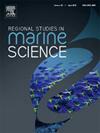Wave prediction using Graph Neural Network at Darwin Harbour, Australia
IF 2.1
4区 环境科学与生态学
Q3 ECOLOGY
引用次数: 0
Abstract
Darwin Harbour (DH), Australia, is a flood-dominated estuary in which the waves substantially influence ocean dynamics, especially in the outer harbour. Hence, the prediction of waves is crucial for coastal activities and management in DH. This paper uses a graph neural network (GNN) model to forecast wave characteristics in the nearshore zone of DH. The model was used for next-frame prediction of the wave parameters such as significant wave height, peak period, wavelength, wave velocity, and wave direction, with the model configured to project future values by assessing parameters at a specific domain and in specific time frames. The GNN framework is intended to identify graph dependence via message passing between the nodes. The input to the model is the wave outputs from a 62-day simulation from the SWAN model. The study was carried out using 7194 nodes, with each node linked to 5 neighbour nodes, to forecast dependencies accurately. The data were split 80/20 % for training and testing purposes. Furthermore, the significance of the number of hours as an input on anticipated outcomes was investigated. The performance of the model was also evaluated for short-term (1 h, 3 h and 6 h) and longer-term (12 h and 24 h) predictions; 17 scenarios were investigated, with one scenario for single-step forecasting, and the others for multi-step forecasting. The GNN model forecasts the wave parameters well, with root-mean-squared errors ranging from 0.06 to 0.13, and correlation coefficients R2 ranging from 0.96 to 0.84, considering all parameters together. Moreover, it demonstrated that increasing the number of hours for input and time steps for forecasting reduced the model’s performance. Finally, the model was compared with the other three popular ML models. The result indicates that the proposed GNN model is useful for spatiotemporal wave prediction and can be integrated with numerical ocean modelling to examine coastal phenomena.
求助全文
约1分钟内获得全文
求助全文
来源期刊

Regional Studies in Marine Science
Agricultural and Biological Sciences-Ecology, Evolution, Behavior and Systematics
CiteScore
3.90
自引率
4.80%
发文量
336
审稿时长
69 days
期刊介绍:
REGIONAL STUDIES IN MARINE SCIENCE will publish scientifically sound papers on regional aspects of maritime and marine resources in estuaries, coastal zones, continental shelf, the seas and oceans.
 求助内容:
求助内容: 应助结果提醒方式:
应助结果提醒方式:


